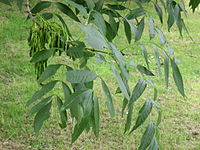
Photo from wikipedia
Bottom ash samples were collected from four lignite power plants of Greece. Granulometric analysis was executed and after homogenization four distinct fractions (>1.25, 0.63-1.25, 0.18-0.63, 1.25 mm), certain differences in… Click to show full abstract
Bottom ash samples were collected from four lignite power plants of Greece. Granulometric analysis was executed and after homogenization four distinct fractions (>1.25, 0.63-1.25, 0.18-0.63, <0.18 mm) were obtained. The samples were analyzed by X-Ray Diffraction (XRD) and Energy Dispersive System (EDS), while thermogravimetry (TG/DTG) and stereomicroscope viewing were applied for the coarse fractions. Furthermore, proximate analysis (moisture, ash, volatiles, fixed carbon) was undertaken and Loss on Ignition (LOI) and calorific values were determined. The particle size distribution revealed that bottom ash satisfies the gradation criteria for concrete and geotechnical applications. The mineral composition included mainly amorphous matter, quartz, plagioclase, calcite and gehlenite and minor amounts of pyroxene, portlandite, hematite, micas etc.. The chemical analysis showed Si, Ca, Al, Mg, Fe, S as major and Ti and K as minor chemical elements, indicating high slagging and fouling potential within the thermal chambers. Based on the chemistry and mineralogy of the bottom ash samples, a potential utilization in concrete manufacturing is discussed, taking into account certain limitations. Based on LOI, proximate analysis, calorific values and TG/DTG profiles of the coarse fractions (>1.25 mm), certain differences in the characteristics of the bottom ash of the younger and the three older power plants were observed. High amounts of unburnt carbon were determined in the coarse fraction (>1.25 mm) of all plants except the younger one, indicating a problematic combustion within the chambers and a potential of reburning these coarse material in a waste to energy application.
Journal Title: Thermal Science
Year Published: 2020
Link to full text (if available)
Share on Social Media: Sign Up to like & get
recommendations!